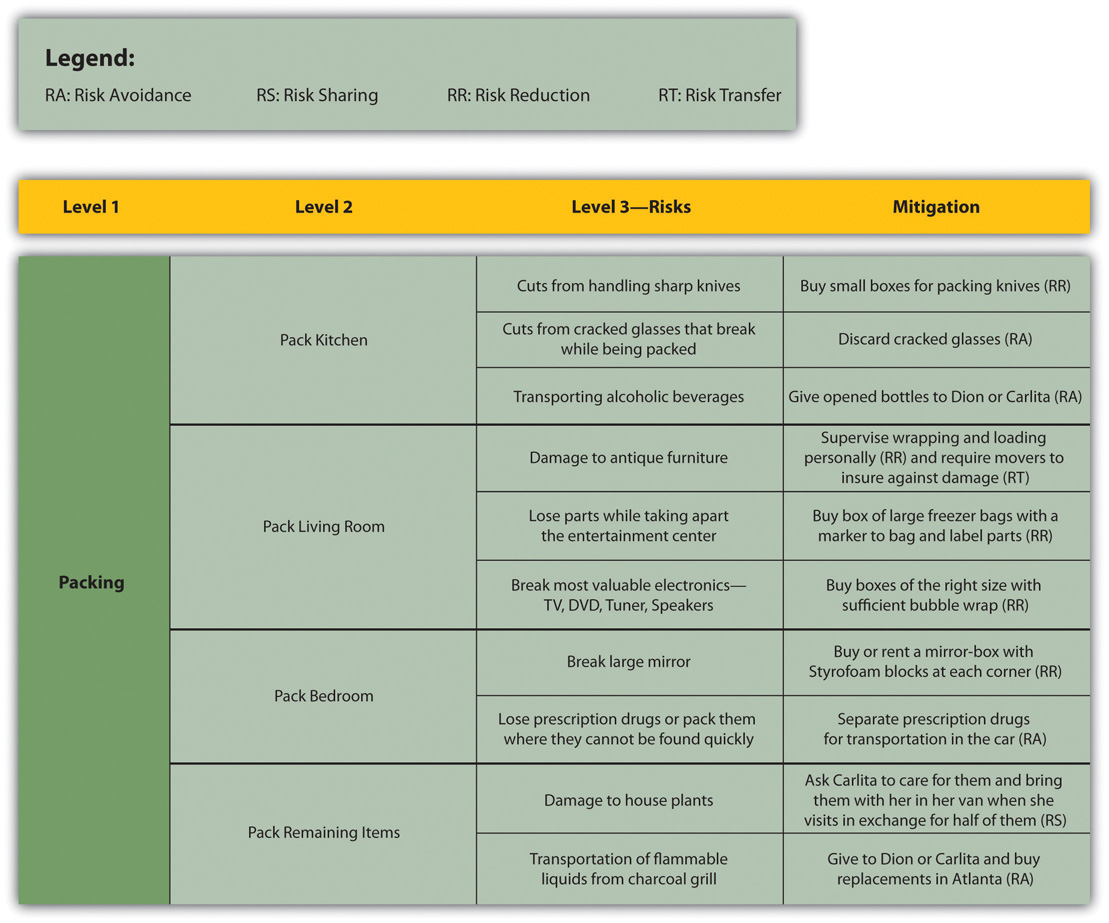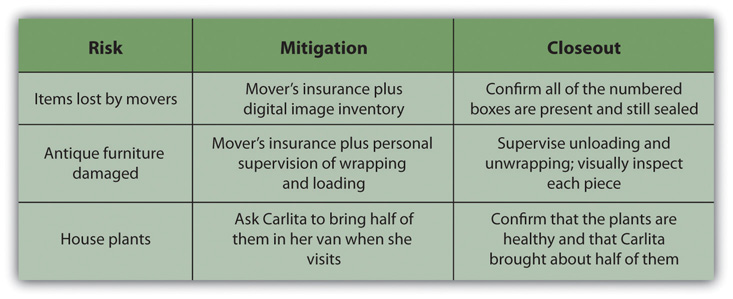Project risk is dealt with in different ways depending on the phase of the project.
Risk is associated with things that are unknown. More things are unknown at the beginning of a project, but risk must be considered in the initiation phase and weighed against the potential benefit of the project’s success in order to decide if the project should be chosen.
In the initiation phase of John’s move, John considers the risk of events that could affect the whole project. He identifies the following risks during the initiation phase that might have a high impact and rates the likelihood of their happening from low to high.
John considers how to mitigate each of the risks.
John concludes that the high-impact risks can be mitigated and the costs from the mitigation would be acceptable in order to get a new job.
Once the project is approved and it moves into the planning stage, risks are identified with each major group of activities. A risk breakdown structure (RBS) can be used to identify increasing levels of detailed risk analysis.
John decides to ask Dion and Carlita for their help during their first planning meeting to identify risks, rate their impact and likelihood, and suggest mitigation plans. They concentrate on the packing phase of the move. They fill out a table of risks, as shown below.
Figure 11.5 Risk Breakdown Structure (RBS) for Packing John’s Apartment

As the project progresses and more information becomes available to the project team, the total risk on the project typically reduces, as activities are performed without loss. The risk plan needs to be updated with new information and risks checked off that are related to activities that have been performed.
Understanding where the risks occur on the project is important information for managing the contingency budget and managing cash reserves. Most organizations develop a plan for financing the project from existing organizational resources, including financing the project through a variety of financial instruments. In most cases, there is a cost to the organization to keep these funds available to the project, including the contingency budget. As the risks decrease over the length of the project, if the contingency is not used, then the funds set aside by the organization can be used for other purposes.
To determine the amount of contingency that can be released, the project team will conduct another risk evaluation and determine the amount of risk remaining on the project. If the risk profile is lower, the project team may release contingency funds back to the parent organization. If additional risks are uncovered, a new mitigation plan is developed including the possible addition of contingency funds.
During the closeout phase, agreements for risk sharing and risk transfer need to be concluded and the risk breakdown structure examined to be sure all the risk events have been avoided or mitigated. The final estimate of loss due to risk can be made and recorded as part of the project documentation. If a Monte Carlo simulation was done, the result can be compared to the predicted result.
To close out the risk mitigation plan for John’s move, John examines the risk breakdown structure and risk mitigation plan for items that need to be finalized. He makes a checklist to be sure all the risk mitigation plans are completed, as shown below.
Figure 11.6 Closeout of Risk Mitigation Plan for John’s Move

Risk is not allocated evenly over the life of the project. On projects with a high degree of new technology, the majority of the risks may be in the early phases of the project. On projects with a large equipment budget, the largest amount of risk may be during the procurement of the equipment. On global projects with a large amount of political risk, the highest portion of risk may be toward the end of the project.
Risk Assessment
Recall a project that you considered at one time but decided against during the initiation phase because the risks were too great or the mitigation plan was insufficient to proceed. Describe the project, the risks, the mitigation plan, and why you chose not to go forward.